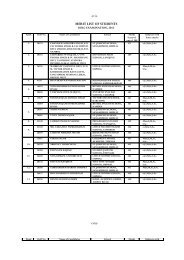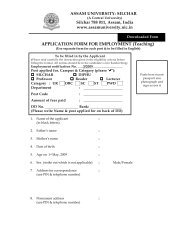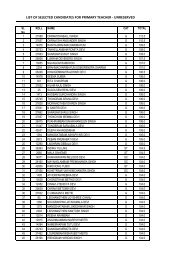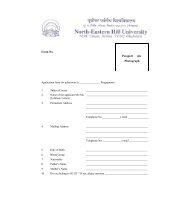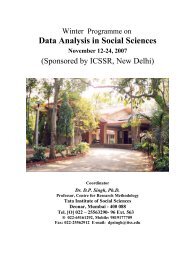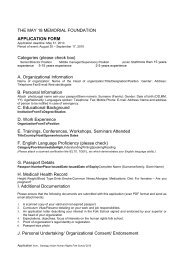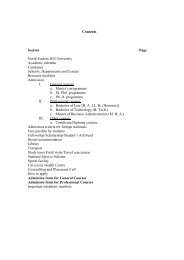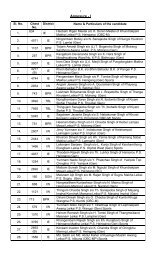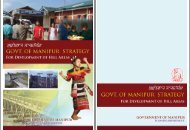AgriManipur - E-paolive.net
AgriManipur - E-paolive.net
AgriManipur - E-paolive.net
- No tags were found...
You also want an ePaper? Increase the reach of your titles
YUMPU automatically turns print PDFs into web optimized ePapers that Google loves.
SAFI InitiativeFood above all<strong>AgriManipur</strong>Vol. 1, Issue 1Nilakuthi Food Park: Going to shape foodindustries?Happenings 3Hot Topic: Food Park 4Underutilized crops 6Know your food 10Ngakra farming 11Meeting with a star 12Meeting with a Star: Shubhra Underutilised crops by Nanita Ngakra farming by BasudhaCoonnect: NHB 13
<strong>AgriManipur</strong> Volume 1, Issue 1Editor viewpoint“Our aim is to addresssuch issues byunderstanding andmitigating the problemsthrough dialogue,discussion anddissemination”We are in the era where pressureof food production strainsevery nation due to high populationgrowth and shrinkingarable land. We are no excepton.Challenge lies in everyoneof us; to produce more fromlimited amount of resources.Answer would be challengingand often coupled with unwantedoffshoots. For instance,use of fertilizer, though spikesyield, spoils the land in longrun. Nearly 50 % of the worldpopulation experiences thepang of hunger; forget aboutmalnutrition! Fundamentalcause points to low productivityor inefficient utilisation ofland. Besides this, loss duringtransportation and storagecontributes significantly todishearteningly low reach-outto people. Given the fact thatimproved production of agriculturalcrops plays a crucialrole in alleviating hunger, povertyand malnutrition, immediateattention is needed to bepaid. So the mantra lies insustainable improvement inagricultural yield.Amidst this troubling situation,there exists a wide disparitybetween countries, statesand regions in terms of agriculturalproductivity. Yield ofcereal of India is half to that ofChina and almost one third ofUS. Such big difference couldresult from varieties of reason .Where is the failure? Whom toblame? Difficult to point. Ouraim is to address such issues byunderstanding and mitigatingthe problems through dialogue,discussion and dissemination.One of the issues that vex thecommon farmers is communicationgap. An intriguing researcharticle by Shanta andPurnima (2009) in Annals ofLibrary and Information Studiesrevealed that knowledge andinformation required by farmersin Manipur for their agriculturalactivities are largelyunmet. Either informationcan‘t be reached or they simplycan‘t understand. Also flow ofinformation is often unidirectional.What‘s wrong with thegovt. machineries where tonsof money were earmarked? Hasmoney been drained somewhere?We believe informationis the key and farmers areempowered by equipping themwith information.Solving staggering needs offarmers and other stakeholdersnecessitates view from differentangles. There is no use of abundantsupply of materials (seeds,implements, manure, etc)when they don‘t have capacityto purchase. Here comes therole of credit. On anotherfront, an employee in publicsectors and MNCs are entitledto healthcare and otherinsurance policies. Who looksafter when they ill? Whatabout the farmers? Thoughthey are doing the most noblejob, they are discourageddue to lack of security. Farmingis, therefore, compelled tobe a secondary option. On thewhole, nation suffers.<strong>AgriManipur</strong>, a brainchild ofSociety of Agriculture, Foodand Innovation, dreams. Wehope readers can enjoy andbelieve that magazine will actas platform for farmers, foodprocessors, entrepreneurs anddirectly reaching their voice toexperts and policymakers inconstructive manner and atthe same time, farmers willalso be benefited by gettingtimely, reliable and motivatingviews and advice.We believe, with reliable information,can emerge successfuldespite the turbulenceand malaise.<strong>AgriManipur</strong>Chief EditorDayanidhi HuidromConsulting EditorN. Bobo MeiteiContributorsY. HemantaA. HemchandraTh. SanajaobaSurendroPublisherHemchandra<strong>AgriManipur</strong> is a quarterly magazinepublished by SAFI (Society for Agriculture,Food and Innovation) Imphal basedNGO. We are happy to receive readerscomments/ view/ criticism.daya.sym@gmail.com©SAFISociety for Agriculture, Food and Innovation,Wankhei Konsam Leikai, ImphalPage 2
<strong>AgriManipur</strong> Volume 1, Issue 1HAPPENINGSGovernor inaugurated Agri Fair 2011April 18, 2011. Three days CAUAgri Fair 2011 on the theme‗Agricultural Technoogies andFarm innovations for prosperityof the north east region‘ wasinaugurated by Manipur governorHis Excelllency GurbachanJagat Singh at the CAU IroishembaImphal. Manipur Governorreiterated the importance ofearning surplus income fromagriculture to enhance the investingcapacity. This, he said, couldbe effected by providing qualityseeds, irrigation, power, machineries,fertilizers, affordable creditsbesides appropriate trade andprice policies. Among the prominentdignatories present inthe inaugural function includesRajya Sabha MP, ShriRishang keishing, Lok SabhaMP Dr. T. Meinya, agricultureMinister Ph. Parijat andVice-Chancellor of CAU Dr.SN Puri.International Chinjak Festival @chinjakfestival.comChinjak festival in action22nd April—1st May, 2011. 10days International Chinjak(Food) Festival organised by TheInnovative Youth Society, inassociation with Dept. of Tourism,Govt. of Manipur, was successfullyconcluded with excitementand hope. It was claimed toattract more than 35000 visitorsand estimated Rs. 7.5 lakh wassold over 10 days. Four interna-tionalcommunitiesfrom China, Thailand, Vietnam,South Korea, Tibet andSaudi Arabia besides numerouslocals stalls were participated inthe 10-days food extravaganza.Managing director of the organisingcommittee, Kh. Athoubaputs his vision, ―To preserve,promote and produce all thetraditional and indigenous foodsof Manipur and the North Easternstates at large.‖ Athouba isalso planning to develop ChinjakValley (a comprehensive touristcentre endorsing various localhandloom n handicraft productsalong with the taste of variousChinjak) in 3 years down the line.Bravo!Chinjak (Food) Festival“To preserve, promote andproduce all the traditionaland indigenous foods ofManipur and the NorthEastern states at large”Bihar to shake agriculture from topApril 26, 2011. In one of thehistoric moves of Bihar CMHon‘ble Nitish Kumar, Cabi<strong>net</strong>meeting on agriculture was held.This reflects the top prioritygiven to this all time neglectedsector in a big way once again.The cabi<strong>net</strong> headed by CM consistsof eighteen ministers fromPage 318 agricultural relevant deparments.Mr. Kumar also directed to form 14committees to tackle various issues.Government has earmarked Rs. 848crore for the 2011 – 2012 to bolstervarious schemes.( Source: Hindu April 27, Bihar setsup its agriculture cabi<strong>net</strong>)State Agri ‘thumps down’ to hybrid seedsJuly 2 , 2011. Deputy Director(Soil Chemist) of Agriculture Ph.Rajendro singh expressed thatdept doesn‘t encourage cultivationof hybrid seeds . Citing reasonsfor this, he stated that theyextract the fertility of the soil to agreat extent. Even seeds cant beseed for further cultivation. Howeverin low laying water loggedarea, due to extremely low productivity,cultivation of hybrid seeds aretaken up on experimental basis.PAC 807, PAC – 401 and recentlyHybrid-813 are procured by theagriculture dept.Source: PoknaphamSpecial courts to check food adulterationJanuary 9, 2011. Each district in the state will have a special court tocheck food adulteration and to punish the accused. Speaking to HueiyenLanpao, a food safety officer of the state Health Department said thatbusinessmen are selling food products by adding substances which areharmful to health and may even be fatal. State Food Safety Department istaking up measures under the Prevention of Food Adulteration Act 1954and Prevention of Food Adulteration Rules 1955.It is for this reason thatspecial courts to deal with food adulteration cases will be set up in alldistricts. He further said that many shops in the state sell adulteratedfood.Source: Hueiyen LanpaoPlant Health Clinics to be set upAuust 23, 2011. In an inauguration function of plant health clinic atdivisional agriculture office at Lamlai, State agriculture Minister Ph. Parijatannounced that plant health clinics will be set up in all the districts ofManipur. He also stated that one clinic is already started working at Agriculturehead office at Sanjenthong . This was the second one in the state.Source: Hueiyen LanpaoContd. on page 15
<strong>AgriManipur</strong> Volume 1, Issue 1HOTTOPIC“Many question remains:Will it crumble like anyother govt set up? Whygovt is hunting forpotential entrepreneurs?Will it provide thefacilities much needed byindustries?”Nilakuthi Food Park: Is it going to shape food industries?‗Food Park‘ was buzzing the circles of food entrepreneursfor quite a long time. Long wait is almost overnow. Highly publicized Food Park at Nilakuthi is crystallisingat last. Sigh of relief! Food park was poised as asuccour to the state much needed food processing infrastructure.Food processors/ entrepreneurs are invitedto assemble together and unleash their prowess. Lastminute high profile call for entrepreneurs in a glossyfront page of local newspapers either indicates its intentionto start with pomp or inability to attract entrepreneurs.Many question remains: Will it crumble like anyother govt set up? Why govt is hunting for potentialenterpreneurs? Will it provide the facilities muchneeded by industries? Will it propel food processingforward and, if yes, how? How will it integrate statefood resources? And many more…Concept of Food ParkFood park or any other park has a simple philosophy –aggregating business entities in a single roof by providing/sharing some facilities which are common to themthereby reducing fixed and running cost. A great idea –sharing for cost effectiveness. In food park, the foodprocessors are located close by so they can enjoy thecommon facility installed in the park. For example,running cold storage individually is an expensive exercisefor small and medium enterprises. Moreover, sometimes,single factory may not use its maximum capacityoptimally. These limitations can be countered by sharing.With proper synchronisation, this may work wonderfor SMEs. Some of the facilities which can beshared include weighing bridge, plastic blowing ma-chines, electric transmission, boiler, etc. Food parkalso help farmers by overriding the middlemenwhich they traditionally rely on and thus reducingthe cost of transaction. It also narrows down the notso-reliablemultiple channels to a few reliable, regulatedand transparent routes. It may be particularlyuseful for developing countries where SMEs aredominant and cost a critical factor.Food Parks in ManipurAs per MoFPI reports, there are two foods givenfinancial supports. First one is MATA Food processingpark. Though call Food Park, it doesn‘t have theattributes of food park since no other factories/ entrepreneursother than MATA itself are operated. Ithas two plants; ginger oil extraction plant designed byCSIR Lab, Trivandrum and multipurpose fruit processingplant designed by CFTRI. MATA fruit processingunit boasts of having non-thermal juice concentrationsystem, funded under PATSER scheme ofDSIR, but faced with problems and commercial productionhas not been started so far. But the goodnews is in 2009 it tie up with Shimla Hills OfferingPvt. Ltd. And since then started producing cannedpineapple slices on limited scale inspite of varioushurdles.Nilakuthi food park is another one funded and managedby state govt. under Manipur Food IndustryDevelopment corporation.CollectioncenterPrimary Procesing Centre (PPC)Sorting & GradingRefrigerated vansPulping & Juice extractionCollectioncenterCentral Processing CentreCommon technical infrastructureCommon facilitiesbasic infrastructure and utilitiesStandard Design facilitiesPage 4Mega food park concept
<strong>AgriManipur</strong> Volume 1, Issue 1Bridge connecting food park and NH37:When to complete?Nilakuthi Food ParkNilakathi Food Park was conceptualised byNABARD under Rural Infrastructure Dedelopmentfund. Food Park at Nilakuthi is a 30 acrefood processing facility located on the nationalhighway just 5 km from the Imphal centre. Itwill house numerous facilities like cold storage,ware house, quality control labs, packaging,tool room, power and water supply, sewagetreatment, etc. It can accommodate around 60units with area about 600 sq. M for each unit.The total project cost is estimated to be Rs3172.4 lakh out of which 13 crore is fromNABARD‘s RID fund and the remaining Rs.18 crore is provided by state govt under specialplan assistance. However, due to steep priceescalation the cost had to be re-evaluated andin doing so, state govt requested planning commissionof india to sanction another Rs. 3. 36crore. PCI generously accepted for utilisatiionduring 2009-10 fiscal year but unfortunatelythe fund was lapsed. Now the ball is the courtof ministry of food processing. The whole storyunderlines the delaying tactics of state govtresulting to suffer the completion of food park.Manipur Food Industry Development Corporation(MFIDC) under the department of commerceand industries is the nodal agency toimplement and operate the food park projectwhile UP based Construction and Design Services,Jal Nigam took up the constructionwork. However many state govt depts. like(PWD, electicity dept, IFCD) are involved inprimay and secondary part of the project likebridge construction, road construction, streetlight, electrification, etc. This is also one of thereasons completion is always a dream. Besides‗lack of urgency‘ by the state govt in release offund, various reasons are attributed to delay inPage 5the completion of food park. Delay inrelease of fund led to delay of completionand the price of the material wasescalated in the process. So, new fundhad to be poured which itself is theworst nightmare of MFIDC.Hurry in publicity in the excitement tocapture media was also seen. ExNABARD (Imphal centre) DGM Sonamanireported in November 2006(Sangai Express) that 33% was almostcompleted and expected to complete inMarch 2007. Quite contradictory, inanother news report , it was reportedthat construction started only in March2007 and target was kept in August2009. Again, govt promised to keep itin order by July 2011. That too failedand extended till December. Now wehave to hope for the best. Our fieldinvestigation revealed many improvementshave been made and there is agreat hope that December dateline maybe a reality.How it will worksCold storageThe present focus is certainly on completionof the contruction. So apparently,the modus operandi has so farnot been well thought; how the day today management will be accomplished?What is source of finance? If fee/ rentalhas to be collected, will it be sufficientto meet variable cost (like maintenance)and fixed cost (like salary)? Besides this,will units maximally use the facilities?If not, can fixed fee be demanded? Theshabby situation of the Takyel industrialestate is a glaring example (thoughstyle may be slightly different). Uniquemechanism may be necessary to usher the full advantageof the park. There is a need for proper synchronisationof facilities to avoid overlap or glut or underutilisation.This is particularly true for cold storagewhere maximum utilisation is necessary from technicaland financial point as well.Entrepreneurs mindWarehouseThe greatest crux so far with regard to the Nilakuthipark is on how to incorporate/ accommodate entrepreneursto the park and system. How many existing/potential food processors/ entrepreneurs have fall inline ? As per our record , only 1/2 entrepreneurshave deposited money to book their space. Thoughthe park looks attractive, few factors are likely to dragtheir interest. Deposit fee for the space is Rs. 5.2lakh. Given the condition that most of the entrepreneurs,excepting a few, are at the level of cottage andmicro level (not even small!), hefty sum of Rs. 5.2lakh is difficult to bite. On the other hand thosesuccessful small/ large scale food entrepreneurs, havetheir own factories and shifting place may not be socomfortable.The space they purchased will be their own; thatmeans mortgage-able. This is a good one but againnot friendly to entrepreneurs. Pakka construction is ahighly cost intensive exercise. So the need for loanmay arise. Can a land of Rs. 5.2 lakh be collateral ofRs. 20 lakh? Normally in most cases banks demandcollateral value much larger than loan amount thattoo land value evaluated by conservative valuers.Bank also normally demand third party security. Inthe essence, concept of the park in the existing formatmay not be lucrative for enterpreneurs.Given the size of the market , entrepreneurs may notbe so interested in gambling over the risky exercise offood business. Frankly speaking, most of the entre-Contd. on page 14
<strong>AgriManipur</strong> Volume 1, Issue 1Underutilized crops of Manipur: Importanceand Prospect- H. NanitaHeisnam Nanita is a junior agronomist working at CentralAgriculture University, Iroisemba, Imphal. She can be contacted atnita_hei@yahoo.comHeisnam Nanita“The average productivityof the horticultural cropsis not even half of thenational productivity.”Introduction:The crops, which are neithergrown commercially on largescale nor traded widely, may betermed as underutilized crops. Atthe best, these crops are cultivated,traded and consumedlocally. The popularity of thesecrops varies from crop to cropand locality to locality. The meritsof these underutilized cropsinclude their easy growth, hardyin nature or ability to withstandunder adverse soil and climaticconditions. Most of them are veryrich sources of vitamins, minerals,and other nutrients such ascarbohydrates, proteins and fats.With greater pitch of publicityand value addition, these underutilizedcrops have the potentialfor future commercialization,wider use and, possibly, in reducingmalnutrition. Since the Indo-Burmese region including Manipuris located at the confluenceof the two tectonic plates, theregion had been the ‗Centre ofOrigin‘ of a variety of angiospermplants and Manipur abounds inextremely rich ge<strong>net</strong>ic resourcesand is one of the richest reservoirsof ge<strong>net</strong>ic variability anddiversity of different horticulturalcrops of which many are underutilized.Scope:Manipur has a geographicalarea of 22327 sq. Km.and it lies between 23.8° N to25.05°N latitudes and 93.03° Eto 94.78 ° E longitude comprisingnine districts. About 90% ofthe total area is covered by hillyterrain and the remaining 10%comprises the valley. The size ofcultivated area is only 9.41% ofthe total geographical area and ofthis total cultivated area 52% isconfined to the valley thereforethe pressure on land in the valleyis thus quite conspicuous. Underthese circumstances, developmentof horticulture is the onlyoption for optimizing returnsthrough judicious utilization ofland and other resources to ensuresustained remunerations. Asurvey by the NABARD in collaborationwith the Departmentof Horticulture and Soil Conservation,Manipur have identified277064 ha as potential areas forgrowing different horticulturalcrops. Out of these potentialareas only 15.5% are exploredand 84.5% are still to be broughtunder horticultural plantationswhich fall on hill districts of thestate. The average productivity ofthe horticultural crops is noteven half of the national productivity.Grain farming proves unremunerativein the undulatingtopography of hilly tracts, whichis deprived of irrigation facilities.Despite the government‘s endeavorsto uplift the region, vast potentialremains unexploited. Itbecomes possible to exploit theuntapped potential of the regionthrough location specific horticultureand subsequently expandingthe area under horticulturalcrops. This production of underutilizedcrops can also be increasedthrough adoption ofscientific technologies.ConservationstrategyPopularizationPolicyGe<strong>net</strong>icimprovementImprove agronomicpackagesValueadditionExploring dietaryvaluesMarket avenuePage 6
<strong>AgriManipur</strong> Volume 1, Issue 1Sl. No. Local Name Common Name Scientific Name Type of Plant uses1. Asi heibong Ficus hispida Tree As Fruit and medicinalplant2. Awa kege Physic nut Jatropha curcus Shrub As medicinal plantand bio-fuel3. Awa phadigom False corrinder Eryngium foetidumHerbAs spice4. Chak hawai Rice bean Phaseolus calcaratusHerbAs Pulse and vegetable5. Chaning Job’s tear Coix lacryma-jobi Herb As Cereal and decorativeitem6. Chantrook Shepherd’s purse Capsella bursa Herb As Spice and vegetable7. Charuyen Volvareilla esculentaFungusAs vegetable8. Ching charot Ophiopogon wallichianusHerbAs Spice and vegetable9. Ching heiyen Antidesna acidum Tree As Fruit10. Elaichi Achouba Greater cardamom Amonum subulatumHerbAs spice11. Eshing ikaithabi Neptunia prostrate Herb As vegetable12. Eshing kambong Zizania latifolia Herb As Vegetable13. Fakchet Alternanthera HerbAs vegetablesessilis14. Fakpai Polygonum posumbuShrubAs spice15. Feija Wenlandia TreeAs vegetableglabrata16. Haona Lemon grass Cymbopogon citratesHerbAs medicinal plant17. Heibi Meyna laxiflora Shrub As Fruit18. Heibong Fig Ficus carica Tree As Fruit19. Heiboong Garcinia anomala Tree As Fruit20. Heikak Water chestnut Trapa bispinosa Herb As Fruitflickr.com/photos/dinesh_valke/ChaningHeibiHeikakPage 7
<strong>AgriManipur</strong> Volume 1, Issue 1http://www.assamesecuisine.comFakchetCont. from page 7……………………………..Underutilized crops ofManipur: Importance and ProspectPoor recognition of these cropsin horticulture promotion programmes.• Improper institutional arrangementsand limited role played byfinancial institutions in settingup of agro industrial and horticulturebased industrial units.Strategies for the developmentof underutilized crops:• Ge<strong>net</strong>ic erosion is very seriousproblem in non-traditional fruitsand many land races will becomeextinct if these are not conservedsoon. Domestication of potentialwild species through homesteadcultivation should be encouragedfor avoiding over-exploitationfrom natural sources.Under-utilized horticulturalcrops are mainly grown/ managedunder traditional farmingsystems by diverse ethnic communities.Increased focus to documentindigenous knowledge isrequired. Such emphasis will helptap value additions as much ofnative diversity is put to multipurposeuses.There is a necessity to make thefarming community aware aboutthe nutritional importance ofunexploited horticultural crops,use of mass media like radio, TV,news paper and other printedliterature can play an effectiverole in creating awareness amongthe farmers.For proper exploitation andbetter economic returns fromunderutilized horticultural cropsemphasis should be given ondeveloping processing units inthis area. It would also provideemployment opportunities to therural folk.The yield and quality of thesecrops are poor which hamper theproductivity. Hence, special effortsare needed on the part ofthe research scientists to developthe suitable location specificpackage of practices of differenthorticultural crops including thedevelopment of superior varieties,and conservation of ge<strong>net</strong>icsresources.Under-utilized horticulturalcrops are nutritionally rich andadapted to low input agriculture.More R & D efforts in these willadd substantially to food security.Limited number of speciesneeds to be targeted for detailedresearch and development inunder-utilized horticultural cropsby national programmes focusingon their conservation and use.Research needs to be geared upboth on species/crops importantfor subsistence farming and those21. Heikru Indian gooseberryPhyllanthus embilicaTreeAs Fruit andmedicinal plant22. Heimang Rhus semialata Tree As Fruit andmedicinal plant23. Heijaang Citrus medica Tree As Fruit24. Heining Hog plum Spondias pinnata Tree As Fruit andmedicinal plant25. Heinoujom Carambola Averrhoea carambolaTreeAs Fruit andmedicinal plant26. Heirangkhoi Amoora rohituka Tree As Fruit andmedicinal plant27. Heiribob Citrus macroptera Tree As spiceFakphai28. Heiri khagok Bael tree Aegle marmelos Tree As medicinalplant29. Heirit Ficus cunia Tree As Fruit30. Heithoom Citrus paradise Tree As FruitPage 8
<strong>AgriManipur</strong> Volume 1, Issue 1http://www.banana-tree.com/Product/AEGLE-marmelos-Bael-Fruit-flicker.comflicker.comHeiri-khagokHeiningHeinajomexhibiting potential to becomecommodity crops.Conclusion:Manipur is bestowedwith the most congenial climaticconditions for the production ofvarious underutilized plant. Theincrease in area and production ofthis plant can provide many foldemployment opportunities in agro-based industries, packaging, storage,preservation, canning andtransportation. Thus there is anurgent need to take up the improvementprogramme of thisplant with collection, conservation,multiplication of qualityplanting material, standardizationof agro-techniques and technologyfor processing and value addition.References:Anonymous (2007), AnnualReport on Technology Mission,Department of Horticultureand Soil conservation, Governmentof Manipur.Rai N., Asati B.S., Patel R.K.,Patel K.K. and Yadav D.S.(2005), Underutilized horticulturalcrops in North EasternRegion, ENVIS Bulletin Vol.13(1), Himalayan Ecology.Sukumar S. S., (2006), Theeconomic plants of Manipurand their uses.“Manipur is bestowedwith the most congenialclimatic conditions forthe production ofvarious underutilizedplant”Dear farmers, food processors, nutritionist, ...torchbearers of ManipurDo you have you story to share?If yes, please feel free to write. Your success stories or setback centered around agriculture,food and nutrition are most welcome no matter how big or small. If required we will try tosolve through our experts’ <strong>net</strong>work. You can write in any languages. We will translate andpublish.Page 9
<strong>AgriManipur</strong> Volume 1, Issue 1Know your FoodParkia roxburghii (Yongchak)Source: http://gardenbreizh.org/photos/karlostachys/photo-281532.Common name:Tree beansYongchak (in Manipuri)Botanical name:Parkia roxburghiiType:Plant (Tree)Family:LeguminoseaeSub-family:MimosoideaHabitat:Commonly grown in thehillsUse:Classical relishinglegume in Manipurisociety; use as maincomponent in vegetablecurry and saladMedicinal use: NASource:Nutitional informationFood Chemistry, Vol. 62,no. 4, pp. 477-481, 1998Moisture(%)a decrease with maturityb increase with maturityProtein (%) 12.1- 18.8 b 28.8Parkia roxburghiiPod Maturekernel6.7 – 8.4 a 10Fat (%) 1-15.5 b 33.5Ash (%) 6.1-7.4 a 5.7Carbohydratesandfibres (%)52.9-71.1 a 22.0Energy(Kcal)342-426 b 505Lemanea australis (Nungsham)Common name:Nungsham (Manipuri)Botanical name:Lemanea australisMedicinal use:Used in the treatmentof diabetes.*Lamanea australisfound in Imphal riverMoisture (%) 76.24±0.88Ash (%) 26.22±0.76An old woman selling NungshamPage 10Type:AlgaeFamily:RhodydophytaHabitat:Grown uner the rocks inflowing river duringwinter in ManipurUse:Dried, fried, roasted; asan adjunct with otherdish. Gives prawn likeflavour.Source:Nutritional informationWorld Journal of Dairyand Food Sciences, 6(1): 27-34, 2011*Assam UniversityJournal of science andTechnology: Biologicaland Environmental Science,Vol. 7. No. 3, 63-66, 2011Crude fiber (%) 0.79±0.4Protein (%) 26.22±0.76Lipid (%) 1.83±0.02Total carbohydrate (%) 26±1.36Total free amino acids (%) 15.8±0.03363.05±0.5Potassium (mg/100 gm) 5474.78±0.2Sodium (mg/100 gm) 8magnesium (mg/100 gm) 111.3±0.53112.26±0.4Calcium (mg/100 gm) 9mean± standard deviation
<strong>AgriManipur</strong> Volume 1, Issue 1Prospects of Clarias magur farming in Manipur- Ch. BasudaCh. Basuda is a scientist working at ICAR Research Complex for NEH Region, ManipurCentre . She is actively involved in developing techniques for scaling up theproduction indigenous fishes and training to farmers. She can be contacted atdevibasu@yahoo.comAquaculture has assumed the status of fastexpanding industry in many countries in theworld. India is basically a carp culture country;the indigenous and exotic carps account forbulk of production. However, interest in theculture of catfish increases rapidly in recentyears due to their high market price and hardynature. Catfishes are easily distinguished bytheir smooth and fewer scale bodies. It lives infresh brackish water and marine habitats. Itcan also be found in marine habitat. Someof the important catfishes found in Manipurare Wallago atu (Sareng), Aorichthyssps (Ngaten), Mystus sps (Ngasep), Ompokbimacuatus (Ngaten), O. pabda, O. pabo,Clarias magur (Ngakra), Heteropneustus fossilis(Ngachik) . They are famous for theirrestorative properties and generally marketedin live state. Hence, these fishes arecommonly known as ‗Live fish‘.These Clariids are a group of fisheswhich, by virtue of the presence of accessoriesrespiratory organ, can thrive well in fallowderelict swampy waters normally consideredas low oxygen environment conditions. Thisability of Clariids to feed and grow in thevirtual absence of dissolved oxygen, coupledwith fast growth, an omnivorous diet andgenerally high resistance to stress, make themof particular interest in aquaculture. Its importancegained momentum since 1985,Clarias magur brooders Hormone injection Stripping of Clarias magur femaleClariid catfishes are grown by small-scaleand large-scale fish farmers in 30 countrieswith a total production of over 3 00 000 t,which was valued at nearly US$400 millionin 2006. Currently, cultured clariid productioncontributes nearly 60% to the totalglobal production (FAO 2009). Twentycountries in Africa, Asia and Europe produceat least 100 t per annum.Among the catfishes Clarias isone of the most important aquaculturespecies in Asia. Clarias magur, commonlyknown as Ngakra in Manipur. It has goodmarket price and fetches a higher price thanthe major carps, owing to its good taste,nutritional and medicinal value. Attemptshave been made for farming of this fish byfew progressive fish farmers in Manipur.However due to inadequate supplies of seedculture of Clarias, production is still verylow. In recent past, C. magur seeds wereavailable in many places in Manipur duringPage 11monsoon and post monsoon months i.e.August-October. The young one of thesefishes were collected in large number frompaddy fields or water logged, low lying areasby employing indigenous fishing devices.The collected fishes were stocked and culturedwith carps in ponds. Collection ofseeds from wild is unreliable, time consumingand uneconomical. To overcome thisconstraint, induced spawning is the onlyoption for supply of quality seeds for Clariasfarming.Recently, ICAR Research Complexfor NEH Region, Manipur Centre anda few progressive farmers produced Clariasseeds for culture by artificial breeding usinghormone injection such as ovaprim, ovatide,wova-FH, etc and stripping.BreedingC. magur exhibits sexual dimorphism anddifferentiating secondary sexual charactersare shape of muscular papilla at vent re-gion. Males have elongated papilla, while femaleswith round button shaped papilla. Thefecundity of this species is very low, though themaximum fecundity recorded was 37720; fisheswith a fecundity range of 15000 to 20000 perkg are common. The breeding period fallsduring June to AugustThe C. magur can be breed by inducinghormones @ 0.8 ml/Kg body weight tofemale. The latency period between injectionand stripping of female is 16 hours at 28°C. The male fishes are held separately in a tankor container before artificial fertilization.Before the female are stripped, male fishwith gravid testis are to be sacrificed, and testesare taken out and macerated in normal saline(0.9% NaCl). The spermatozoa become inactivein this medium and this extract can bemaintained for few hours in refrigerator. After16 hours of latency period female fish isstripped and ova are collected in to dryContd. on page 16
<strong>AgriManipur</strong> Volume 1, Issue 1Meeting with a Star: Subhra HanjabamSubhra Hanjabam, a multifaceted personality, takes food processing to her heart.Master in nutrition, Subhra started her journey with a single pan and no budget at all.Her formidable courage makes her today a household name of indigenous foodproducts. Her enterprise, Meira Food, is also a symbol of women empowerment. Theindustry is exclusively run and managed by women only. Please find out more abouther and her mission.Subhra Hanjabam“My social & moralresponsibility towardssociety gave mestrength to mymaterialize my dream”1. <strong>AgriManipur</strong>: When and howwas the enterprise established?Subhra Hanjabam (SH): MeiraFoods was established in the year2004 under the aegis of Actionfor Community TransformationManipur (ACT-M). Under theSponsorship of MSME, Takyelpatconducted a training on Foodand vegetable preservation training.After completion of thecourse most of them expressedtheir inability to state a unit.When I invited them to workwith me out of 30 participants, 5of them turn up. That was howwe started products, trying outnew thing and variety to the market.2. <strong>AgriManipur</strong>: What attractsyou to take fruit and vegetableprocessing as your profession?SH: After my completion of MasterDegree in Food & Nutritionin the year 1990 from BanasthaliVidyapith, Rajasthan, I triedmany govt. jobs. But fortunatelyor unfortunately that was theperiod when govt. banned mostof the Govt. recruitment. Afterappearing many of the writtenexaminations and interviewresults never come out. I servedin Private college (WangkhemMani Girls College), participatedin water analysis project work,joined All India Radio as CasualAnnouncer, and joined NGOactively. None of the above jobssatisfied me except working inNGO (I work 13 years withNGOs). That‘s when I learnedworking with people and socialactivities. I was interested ineconomic improvement ofwomen, solving of the crucialproblem of society like unemploymentand industrialist processfor improving state economy.My educational background andavailability of fruits and vegetableshelp to select processing offruits and vegetables as my ultimateprofession.3. <strong>AgriManipur</strong>: What drivesyou to run this business forlong time when many ofother industry perish?SH: My social & moral responsibilitytowards society gave mestrength to my materialize mydream. My girls (who are workingwith me) untiring support andsharing faith in me make me toface all the difficulties. One esteemedcustomer guided us toproduced more variety of productsof their taste. My family andfriends supported us in all thepossible way. I am thankful all ofthem.4. <strong>AgriManipur</strong>: Would yougive a brief picture of balancesheet of your business?SH: We started on business withzero investment. Whatever Ihave in kitchen we utilised it.Whatever we received after thesale of our product was firstinvestment. We reinvest whateverwe earn and expanded ourbusiness.5. <strong>AgriManipur</strong>: As a foodprocessor and businessmanwhat kind of difficulties werefaced/ are facing? Technical,financial and emotional?SH: As we have endless opportunity,difficulty also follows.But belief in the saying―Where there is a will there isa way‖. Being a life member ofAssociation of Food Scientist& Technologist, India(AFSTI), Manipur Chapter,members of Association extendall possible help whenever any Technical difficulty isthere. My girls, friends andfamily are there to support mewhen ever I feel helpless. I amnot happy with financial instituteswhich makes so difficultto receive any financial help.Friends and family always supportedwhenever I‘m in need.6. <strong>AgriManipur</strong>: What kind ofsupports are needed for thewelfare of small scale entrepreneurs?SH: For the welfare of small Scaleentrepreneurs, financial institutesshould come forward to supportus those who are genuinely workingand has future in it. Governmentshould provide more oftechnical service to these industries.Basic needs like electricityand water should be provideduninterrupted. Some incentivePage 12
<strong>AgriManipur</strong> Volume 1, Issue 1and welfare scheme for the workersto meet their family needs arealso imperative.7. <strong>AgriManipur</strong>: What problemsare being faced by small scalefood processors in general ?SH: Till now no large problemare faced except fluctuations ofprice due to frequent bandhs &blockades.8. <strong>AgriManipur</strong>: What in youropinion is the future of foodprocessing and its business inthe state?SH: With improvement in itsquality, packaging and diversificationof products according tomarket demand, there is a hugescope to accelerate the businessand move beyond the state.9. <strong>AgriManipur</strong>: As you knowtoday’s youth are less botheredabout entrepreneurship or hardearned profession but insteadchoose short cut route to earntheir livelihood. This may affect the society. Do you have any suggestionto reverse this trend?SH: Earning by short cut method always disturb the integrity of a person. Itgives more of ill effect to the society rather than helping them. I am creatingan environment to earn by working hard. Being in production, I amnot only helping to meet personnel requirement but also the economy of asociety; creating a sustainable society, for today and for ever.<strong>AgriManipur</strong>: Thank you very much. Hope you have great future andenlighten our generation.CoooooNECTHope this will connect you with useful information you are longing for. This information hub intendsto help you in advancing your enterprises/ business making use of it.NATIONAL HORTICULTURE BOARDWhat is it?NHB is an autonomous society set up by Govt. of India in 1984 with a mission to promote horticulturehorticulture sectors by infusing technologies and capabilities along the horticultural chain.Its objectives are multifold which includes development of hi-tech commercial horticulture in identifiedbelts, development of integrated, energy efficient cold chain infrastructure for fresh horticulture produce, transfer of technology to producers/farmersand service providers such as gardeners, farm level skilled workers, etcWhat schemes it has?Development of Commercial Horticulture throughProduction and Post-Harvest Management of horticulture cropsCapital Investment Subsidy Scheme for construction/expansion/modernization of Cold Storages/Storages of Horticulture ProduceTechnology Development and Transfer for Promotion of HorticultureMarket Information Service Scheme for Horticulture CropsHorticulture Promotion ServiceMost of the the shemes gives back-ended capital subsidy upto 20% - 33%Contact addressMinistry of Agriculture, Government of India85, Institutional Area, Sector - 18Gurgaon - 122015 (Haryana)http://www.nhb.gov.inEmail: info@nhb.gov.inPage 13North East Regional OfficeChhibber House4th Floor, Dispur Post OfficeGuwahati, 781005Tele/Fax : 0361-2599141, 2340695E-mail : nhbghy-mic@yahoo.co.in
<strong>AgriManipur</strong> Volume 1, Issue 1Contd. from page 5preneurs are in the cottage / self- help group level,so jumping directly into bigger landscape may betechnically and financially unwarranted.Besides the infrastructure provided by the foodpark, there are other issues that seriously affect thebusiness of larger degree. Cost of transport is excessivelyhigh. For example, the cost of transportingcanned pineapple from Imphal to Delhi is almosttwice to that of Guwahati to Delhi. Raw materialsalso become uncompetitive when it reach Imphal;thanks to geographical accident and unofficial tax.On the other side, sea change is required fromhorticulture perspective. Unreliability of fruits growersis also one good reason that affects the processing.Unless growers produce what processorswants, a win—win situation appears remote. Costalso needs to be brought down to make it competitivewhich on the other side demand use of technologyand GAP (Good Agricultural Practices). Inthe present context, there is wide gap between thegrowers and processors. State fruits procurementgrid would be help in fixing the issue facing by foodprocessors.Plus pointsThere are also many positive points that may overshadowpainful points. Envisaged dedicated electricline would be an attracting factor to pull entrepreneurs.However, excepting few industries like millingand bakeries, the fruit n vegetable processingindustries requirement of electricity is very limitedFew Factsby the size and nature of the business. 24 x 7electric supply will certainly help the foodindustries. Packaging facility is the need ofthe hour. Packaging machines includingPET Blowing machines at the park will certainlyhelp the investors. It will not onlylower the cost but will ease the business bynarrowing down physical distance which isnow facing by food processors. Quality controllab can assist in taking preventive measuresfrom impending dangers and will alsoable to enhance the reputation of the products.Concluding remarksNilakuthi Food Park will be a landmarkpoint in the state from industrial perspective.But this should not only be in physicalsense. Action is what is required. Investorsand buyers alike were puzzling how to cometo Manipur and take advantage of statefood resources. This may no longer be thestory. This will be a gateway for future investorsand buyers in the state.There are bigger challenges ahead. Maintenanceis more taxing that just erectingbuildings. To avoid future collapse, operationalmechanism needs to be worked outwell in advance. Success is important. Nationwill not only praise; Manipuri denizenswill be injected with ‘we can do‘ attitude. Isit not that we all need?Schemes for Food Parks under 10th five yea plan was reformulated as Mega Food Parks Scheme (MFPS) for11th five year plan. 15 MFPS have been approved.MFPS aims to raise the processing of perishable (fruits nd vegetables) from existing 6% to 20% and to increasethe global food trade from 1.5 % to 3%.Rs. 1000 crore Patanjali Food and Herbal park , claimed to be biggest in the world, is starting soon. It is locatedat Haridwar, UP and promoted by yoga guru Baba Ramdev.Entire North East has only one Mega food Park, North East Food Park. The Central Processing Centre (CPC)of the Mega Food Park will be housed in 58.41 acres of land located at Nathkuchi Village near the Tihu township of Nalbari District in Assam. The site is only 90 Kms from Guwahati City .Page 14
<strong>AgriManipur</strong> Volume 1, Issue 1Contd from page 3…………………………………………………. HAPPENINGSArum cultivation takes over paddy in WainemAugust 9, 2011. With cultivationof Arum turning out to be moreprofitable than paddy, the farmersin Wainem village of Senapatidistrict have taken to Arum cultivationin a big way. The hill cliffof the village where traditionallyPaddy used to be cultivated havebeen taken over by Arum todaywith farmers earning a minimumof Rs 46,000 from cultivation ofArum over one Sangam of land.Secretary of Rani Gaidinliu SHGMajasilui explained that initiallywomenfolk of the village formed10 SHGs and as beneficiaries ofthe World Vision of India membersof these SHGs started cultivationof Arum over 4 Paris ofland with the seeds providedfrom the side of World Vision ofIndia. Majasilui further informedthat around 1200 to 1300 kg ofArum is normally produced fromone Sangam of land and fromselling them at the minimum rateof Rs 30 per kg, one can earnedaround Rs 46,000 very easily.Source : Sangai ExpressDo you know?Root of arum is used forc o l d s a n d s w e l l i n g(inflammation) of the throat.It is also used to promotesweating and to loosen chestcongestion. However itssafety is an area of concern.Some varieties are poisonous.Source: www.webmd.comChilli variety brings pride to Ukhrul villageAugust 31 2011: Around 5tonne of Chillies have beenproduced in the 2nd HatheiPhanit (Chilli festival) whichwas held at Sirarakhong villagewith the stated objective ofpromoting a variety of Chillygrown in the village which isknown for its taste and look.Sirarakhong village is locatedaround 60 kms from Imphal,close to the road connectingMahadeva and Pfuzero viaTolloi under Ukhrul district.It is said that the cultivation ofthe particular Chilli varietyfound in the village startedsince the days of yore by theforefathers of the villagers andthey still continue with thepractice reaping rich dividendyear after year.Unfortunately, major chunk ofthe production could not reachthe markets at Imphal on accountof the deplorable roadcondition.In such a situation, the Chilliesproduced in Sirarakhong village istaken to neighbouring Nagalandand other States including Assamwhere there is great demand. Duringthe 2nd Hathei Phanit whichwas underway at the village today,many people who understand thequality of the Chilli variety turnedup from different parts of the Stateto make purchases of the Chilli andits products made from it to theirhearts' content.Source : Sangai ExpressIntelligent Advisory System for Farmers (IASF) launchedPage 15August 11 2011: IntelligentAdvisory System for Farmers(IASF), an expert advisorysystem for answering queriesrelated to farming activitiescarried out in North EastStates of India, was launchedat Agriculture Directorate,Sanjenthong today. Thelaunching function was gracedby Agriculture Director L Palendro,CAU Department ofAgronomy Prof L Nabachandraand AgricultureJoint Director O Nobo aschief guest, guest of honourand president respectively.Through inter<strong>net</strong>, the IASFwould provide expert adviceregarding farming activitiesand associated problems.Thesystem supports languages likeManipuri, Assamese, Mizo,Bangali, Khasi etc. The systemwould also provide a platformfor knowledge sharing by experts,students and farmers throughdiscussion forums. Experts can alsosend alerts and useful informationto farmers from time to time. TheIASF was installed with mo<strong>net</strong>aryfrom the Ministry of Communicationand IT, and necessary data andinformation would be uploaded bythe Centre for Development ofAdvance Computing.Source : Sangai Express
<strong>AgriManipur</strong> Volume 1, Issue 1Fertilized eggs Fertilized eggs clung to hyacinth roots C. magur hatching in well aerated FRP tank4 days old embryo of C. magur Well prepared nursery pond for C. Magur C. magur fingerlingstray. Before fertilization milt (spermatozoa)extract medium is activated by addition offresh water, sperms become active and motilityof sperms can be confirmed in microscope.Sperm preparation thus obtained willbe sufficient to fertilize the ova stripped from2 females. Sperm extract is sprinkled over theova and gametes are mixed gently using with abird feathers and allowed to 2 to 3 minutesfor fertilization and washed with fresh andclean water. After repeated washing with freshwater fertilized eggs are transferred to hatchingtrays for incubation.After transferring the fertilized eggs to theflow through incubating system, a feeble flowof water was provided to maintain good waterquality. The water temperature between 27and 28°C was maintained for developmentand hatching.Page 16Source: www.kidsfishing.orgNursery rearing:Clarias fries requires very shallow water level 2-3 ft, because at deeper water they could notswim to surface for gulping air hence died. C.magur is better suited to these shallow waters.In addition to their suitability for culture inderelict waters those catfish can also be culturedin proper well-managed shallow ponds.Pre-stocking nursery pond preparation includedthe removal of aquatic weeds andpredatory fish followed by liming and fertilizationswith organic manures and inorganicfertilizer.Recommended stocking density of Clarias is50,000/ha. However, in Thailand the stockingdensity of Clarias is very high 60-100 fingerlings/m2 (6-10 lakhs/ha). C. magur easilytrained to feed on artificial feed such as fishmeal mixed with rice bran, low grade meat, etc.Fish offal, slaughter house waste also accepted.Growth is commensurate with feeding. On anaverage the conversion rate with recommendedfeed is 1.5-2.0. Under favourble condition clariasis expected to attain weight upto 130g in sixmonths of growing period.Production potentials of C. magur inManipur have been amply assessed by a series offield demonstration in different local conditions.In monoculture production were rangingfrom 1,000kg to 7500kg ha in 4-12 months. Amixed culture demonstration of clarias withAnabas and Heteropneustes at a stocking rate of25,000/ha in a derelict swampy pond of 0.04without supplementary feeding and fertilization.From aquacultural point of view, Manipuris endowed with vast water resources thatcan be use for Clarias production.Given the fact that ngakra is a highlyvalued fish relishing among most communities inManipur, their mass and cost effective production isthe need of the hour. Large scale breeding had beenquite a big challenge among famers and scientists. Thepresent effort is a move in this direction. Mass productionwill not only help the farmers achieving goodeconomic return but will also encourage economicindependence and ensure nutritional security for thestate.
<strong>AgriManipur</strong> Volume 1, Issue 1WORLD FOOD DAYWorld Food Day was established by FAO's Member Countries at the Organization's Twentieth General Conference in November1979. The date chosen - 16 October - is the anniversary of FAO.The Food and Agriculture Organization (FAO) of the United Nations celebrates World Food Day each year on 16 October,the day on which the Organization was founded in 1945.The objectives of World Food Day are to:encourage attention to agricultural food production and to stimulate national, bilateral, multilateral andnon-governmental efforts to this end;encourage economic and technical cooperation among developing countries;encourage the participation of rural people, particularly women and the least privileged categories, in decisionsand activities influencing their living conditions;heighten public awareness of the problem of hunger in the world;promote the transfer of technologies to the developing world; andstrengthen international and national solidarity in the struggle against hunger, malnutrition and povertyand draw attention to achievements in food and agricultural development.THEMES2010 - United against Hunger2009 - Achieving Food Security in Times of Crisis2008 - World Food Security: the Challenges of Climate Change and Bioenergy2007 - The Right to Food2006 - Investing in agriculture for food security2005 - Agriculture and intercultural dialogue2004 - Biodiversity for Food Security2003 - Working together for an International Alliance Against Hunger2002 - Water: source of Food Security2001 - Fight Hunger to Reduce Poverty2000 - A Millennium Free from Hunger1999 - Youth Against Hunger1998 - Women Feed the World1997 - Investing in Food Security1996 - Fighting Hunger and Malnutrition1995 - Food for All1994 - Water for Life1993 - Harvesting Nature's Diversity1992 - Food and Nutrition1991 - Trees for Life1990 - Food for the Future1989 - Food and the Environment1988 - Rural YouthExcerpts from http://www.fao.org/getinvolved/worldfoodday/Page 171986 - Fishermen and Fishing Communities1985 - Rural Poverty1984 - Women in Agriculture1983 - Food Security1982 - Food Comes First1981 - Food Comes First1987 - Small Farmers2011
<strong>AgriManipur</strong> Vol. 1, Issue 1How to reach us?SafinManipur@gmail.comdaya.sym@gmail.com011-91-9856150655011-91-9862831561Society-for-Agriculture-Foodand-InnovationNext issueFebruary 2012Food Crisis: An InsightNational Food Security Act : Promise to alleviate hunger?Plus all the regular featuresGrap your copy todayRate(single copy)Rate(annual)Individual Rs. 20/- Rs. 60/-Institution* Rs. 80/- Rs. 320/-Student Rs. 15/- Rs. 45/-3 publication peryear<strong>AgriManipur</strong> is an initiative of Society for Agriculture,Food and Innovation



